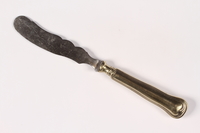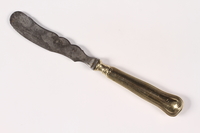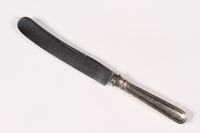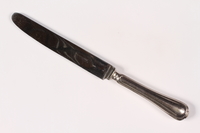Overview
- Brief Narrative
- Small, illustrated children’s songbook taken with Nellie Wiesenthal when she immigrated to the United States in January 1939, from Berlin, Germany, via Switzerland and France. The booklet was published in Berlin, on February 15, 1891, and printed by Julius Sittenfeld. On January 30, 1933, Adolf Hitler was elected Chancellor of Germany. Following the passage of the Nuremberg laws in 1935, Nellie’s father, Fritz, began looking for places where the family could immigrate as life became increasingly difficult. Later that year, Fritz, a doctor, and Nellie’s mother, Gertrude, sent her older sister, Illa, to boarding school in England. When Nellie was no longer allowed to attend public school, she moved into her paternal grandmother Ernestine’s home and attended a local Jewish school. In 1938, Fritz left for the US in order to begin studying for the medical boards he needed to pass in order to practice medicine there. He sent for Illa in August, and in September, Nellie, went to Switzerland with her paternal aunt Helene and three cousins. When her aunt’s family left to wait for their American visas in Cuba, Nellie was taken to a children’s home in Lucerne, until a family friend could escort her to France. Once in Cherbourg, Nellie boarded the SS Deutschland, and arrived in New York City in January 1939. Gertrude arrived in March. Later that year, Ernestine traveled to London, England, to wait for her American visa. In the fall of 1942, Ernestine traveled to the US in a Greek convoy.
- Title
- Kinder-Lieder fur zwei Kleine
- Alternate Title
- Children’s Songs for Two Little Ones
- Date
-
publication:
1891 February 15
emigration: 1939
- Geography
-
publication:
Berlin (Germany)
en route: New York (N.Y.)
- Credit Line
- United States Holocaust Memorial Museum Collection, Gift of Nellie Fink
- Contributor
-
Subject:
Nellie Fink
Printer: Julius Sittenfeld
- Biography
-
Nellie Wiesenthal (b. 1930, later Fink) was born in Berlin, Germany, to father, Fritz (1893-?) and Gertrude Loewenberg (1898-1986) Wiesenthal. Both sides of her family were assimilated and had lived in Berlin for several generations. Her father was a medical doctor, like his father, Otto (1859-1930), and grandfather, and specialized in Ophthalmology. His mother, Ernestine (1873-1947, née Unger) stayed at home. The family had an estate, Cartlow, several hours from Berlin where they often went for vacations. Gertrude’s father, Caesar, had been in the import-export business. He died young, and Gertrude’s mother, Anna, later married Josef Lehman. Nellie had one older sister, Illa (b. 1921, later Ilse). Their mother, Gertrude, suffered from an obsessive compulsive neurosis that made her fear she might get her children sick because she thought that she was carrying diseases like polio, meningitis, and scarlet fever. This condition controlled much of her life, and she often spent her days washing and cleaning items repetitively. She was often away in sanatoriums due to her condition, and when Nellie was very young, her mother began living apart from the family.
In 1933, Hitler was appointed Chancellor, and by that spring, anti-Jewish legislation was in effect. The Nuremburg laws were enacted in 1935, and life for Jews in Germany became extremely difficult and dangerous. That year, Nellie’s father, Fritz, and grandmother, Ernestine, took a trip to Palestine in search of a safe place to live. Eventually, Fritz decided that it would be better to resettle in the United States because they had family there. In 1935, Illa was sent to boarding school in England. In 1936, Nellie was forced out of public school and enrolled in the Goldschmidt School near her grandmother’s house, so she went to live with her. German insurance and social security payments to Jews were no longer authorized, which sent her father’s medical practice into decline. Eventually, Jews were no longer able to practice medicine, and Fritz made plans to go to the US. In the spring of 1938, Fritz visited Illa in Brussels, Belgium, on his way to the US. After finishing school in England, Illa had moved there to study at a convent school, St. Dorothe. She focused on learning French, as well as secretarial and domestic skills, because her father felt that she would need to be able to make her own living once they got to the United States.
Fritz arrived in New York on April 14, and lived with Gertrude’s brother Walter Loewenberg, and his wife, Annemarie, both physicians, who had left Germany at the end of 1935. At that time, German doctors could practice medicine in New York without taking the medical board exams. That was changed in 1937, due to the large influx of refugees and concerns regarding competition. This meant that Fritz had to study and retrain for the exams. Several months later, Fritz sent for Illa who arrived in the US on August 12. In September, Nellie, who was still living with her grandmother in Berlin, was sent to Switzerland with her aunt, Helene Meyer (1892-?, née Wiesenthal), and her three cousins, Eva, Peter, and Angelika. Ernestine could not leave because she was unable to acquire the necessary papers. Helene and the children stayed in a hotel in the town of Horv-Winkel. One day, Helene’s husband, Edgar (1893-1963), who had been in the US, returned to take his wife and children to Cuba, where they would wait to get US entry visas. Nellie’s father did not want her to take that roundabout journey, so she was placed in a children’s home in Lucerne until arrangements for her journey were finalized. During the trip to Cuba, Nellie’s cousin Angelika fell ill and died. The remaining family members eventually made it to Florida, and later settled in New Jersey.
In late 1938, a family friend, Frau Kehrli, arrived at the children’s home to take 8-year-old Nellie to Paris, France, and then on to Cherbourg. Nellie boarded the SS Deutschland, along with a governess hired by her family. The ship arrived on January 28, 1939, and Nellie was reunited with her family in New York. Nellie’s arrival was covered by the newspapers, which wrote about how brave it was for a little girl to travel so far without her parents. At first, Nellie stayed with her uncle Walter and aunt Annemarie. Nellie’s father, Fritz, worked as an ambulance doctor, and lived at St. John’s Hospital in Brooklyn while he studied for the board exams. In March, Nellie’s mother, Gertrude, immigrated to the US. Later on, Nellie went to live with several different family friends and acquaintances throughout New York City and on Long Island, and briefly in Florida with Helene. Her sister, Illa, lived with an American family as an au pair and had a day job as a secretary.
Nellie’s grandmother, Ernestine, emigrated from Berlin to London, England, in late 1939. While waiting for US immigration papers, Ernestine lived in a rented room and spent her time knitting supplies for the Red Cross. In 1942, Ernestine received her immigration papers, and was one of seven female passengers in a three-week-long convoy of Greek freighters travelling across the Atlantic Ocean. In New York, Ernestine was reunited with her family and taken to her daughter Helene’s house in New Jersey. Nellie had not known that she was on her way, and when she went to visit her aunt that weekend, she was incredibly surprised to see her grandmother. Fritz passed the medical exams that year, and established a private ophthalmological practice. Soon the family was living comfortably, and in the same home for the first time in years. Nellie’s mother continued to live apart from the family, and Ernestine cared for them and kept house. After graduating from high school, Nellie attended Queens College, CUNY. In the summer of 1950, Nellie attended summer school at the University of Wisconsin, and she met Sheldon Fink. In 1952, Nellie graduated from college, and in August, she married Sheldon. The couple settled in Chicago, and had two sons.
Physical Details
- Language
- German
- Classification
-
Books and Published Materials
- Category
-
Books and pamphlets
- Object Type
-
Children's books (lcsh)
- Genre/Form
- Pamphlets.
- Physical Description
- Book; 12 p.; ill.; 13.5 cm.
Thin booklet of rhyming song lyrics or poetry printed in Fraktur style font in black ink with red highlights on tan paper sheets, and held together at the spine with two metal staples. Each page has a decorative border framing the text, and there are simple black illustrations on half of the pages. The corners are folded, the pages are discolored, and the lower spine is beginning to tear. - Dimensions
- overall: Height: 6.125 inches (15.558 cm) | Width: 4.250 inches (10.795 cm)
- Materials
- overall : paper, ink, metal
Rights & Restrictions
- Conditions on Access
- No restrictions on access
- Conditions on Use
- No restrictions on use
Keywords & Subjects
- Topical Term
- Children's songs, German. Holocaust, Jewish (1939-1945)--Germany--Berlin. Jewish children in the Holocaust--Germany--Berlin. Jewish refugees--United States. Jews--Persecutions--Germany. Jewish families--Germany--Berlin. World War, 1939-1945--Refugees--United States.
- Geographic Name
- Berlin (Germany) Switzerland. France. New York (N.Y.)
Administrative Notes
- Legal Status
- Permanent Collection
- Provenance
- The songbook was donated the United States Holocaust Memorial Museum in 2012 by Nellie Fink.
- Record last modified:
- 2023-07-10 15:01:43
- This page:
- https://collections.ushmm.org/search/catalog/irn531153
Download & Licensing
In-Person Research
- By Appointment
- Request 21 Days in Advance of Visit
- Plan a Research Visit
- Request to See This Object
Contact Us
Also in Nellie Wiesenthal Fink family collection
The collection consists of artifacts, correspondence, documents, and photographs relating to the experiences of Ernestine Wiesenthal, her son, Fritz, his wife, Gertrude, and their daughters, Illa and Nellie, in Germany, England, and the United States before and during the Holocaust.
Date: 1891-1939

Henckels table knife with a scalloped edge brought with German Jewish prewar refugee
Object
J.A. Henckels table knife taken with Ernestine Wiesenthal when she emigrated from Berlin, Germany, to London, England in 1939. A partially worn maker’s mark bearing twins with arched legs and interlocking arms is engraved on the blade. This iteration of the Henckels mark was utilized from 1900 until well into the middle of the Twentieth century. The knife matches another knife in the same collection (.3), and the handle is likely silver, though it does not bear any marks to confirm that. On January 30, 1933, Adolf Hitler was elected Chancellor of Germany. Following the passage of the Nuremberg laws in 1935, Ernestine’s son, Fritz, began looking for places where the family could immigrate as life became increasingly difficult for German Jews. Later that year, Fritz, a doctor, and his wife, Gertrude, sent their daughter, Illa, to boarding school in England. When their daughter, Nellie, was no longer allowed to attend public school, she moved into Ernestine’s home and attended a local Jewish school. Eventually, Jews were no longer able to practice medicine, and the family needed to emigrate. In 1938, Fritz left for the US in order to begin studying for the medical boards he needed to pass in order to practice medicine. He sent for Illa in August 1938. Nellie arrived in January 1939, and Gertrude arrived in March. Once in London, Ernestine spent her time knitting for the Red Cross. In the fall of 1942, she traveled to the US aboard a freighter in a Greek convoy.

Henckels table knife with a scalloped edge brought with German Jewish prewar refugee
Object
J.A. Henckels table knife taken with Ernestine Wiesenthal when she emigrated from Berlin, Germany, to London, England in 1939. A partial maker’s mark is visible, but is missing the twin mark that identifies when a Henckels piece was manufactured. The knife matches another in the same collection (.2), which does have the twin mark with arched legs, which was utilized from 1900 until the middle of the Twentieth century. The knife handle is likely made of silver, though it does not bear any silver marks. On January 30, 1933, Adolf Hitler was elected Chancellor of Germany. Following the passage of the Nuremberg laws in 1935, Ernestine’s son, Fritz, began looking for places where the family could immigrate as life became increasingly difficult for German Jews. Later that year, Fritz, a doctor, and his wife, Gertrude, sent their daughter, Illa, to boarding school in England. When their daughter, Nellie, was no longer allowed to attend public school, she moved into Ernestine’s home and attended a local Jewish school. Eventually, Jews were no longer able to practice medicine, and the family needed to emigrate. In 1938, Fritz left for the US in order to begin studying for the medical boards he needed to pass in order to practice medicine. He sent for Illa in August 1938. Nellie arrived in January 1939, and Gertrude arrived in March. Once in London, Ernestine spent her time knitting for the Red Cross. In the fall of 1942, she traveled to the US aboard a freighter in a Greek convoy.

Monogrammed dinner knife brought with a German Jewish prewar refugee
Object
Dinner knife engraved with Ernestine Unger Wiesenthal’s initials and taken with her when she emigrated from Berlin, Germany, to London, England in 1939. The threaded design and script used for the initials match another knife from the same donor (2008.204.5), in addition to a ladle (.4) in that collection as well. The knife handle is likely made of silver, though it does not bear any marks to verify that. On January 30, 1933, Adolf Hitler was elected Chancellor of Germany. Following the passage of the Nuremberg laws in 1935, Ernestine’s son, Fritz, began looking for places where the family could immigrate as life became increasingly difficult for German Jews. Later that year, Fritz, a doctor, and his wife, Gertrude, sent their daughter, Illa, to boarding school in England. When their daughter, Nellie, was no longer allowed to attend public school, she moved into Ernestine’s home and attended a local Jewish school. Eventually, Jews were no longer able to practice medicine, and the family needed to emigrate. In 1938, Fritz left for the US in order to begin studying for the medical boards he needed to pass in order to practice medicine. He sent for Illa in August 1938. Nellie arrived in January 1939, and Gertrude arrived in March. Once in London, Ernestine spent her time knitting for the Red Cross. In the fall of 1942, she traveled to the US aboard a freighter in a Greek convoy.

Henckels dinner knife brought with a German Jewish prewar refugee
Object
J.A. Henckels table knife taken with Ernestine Wiesenthal when she emigrated from Berlin, Germany, to London, England in 1939. A partial maker’s mark is visible, but is missing the twin mark that identifies when a Henckels piece was manufactured. The knife handle is likely made of silver, though it does not bear any marks to confirm that. On January 30, 1933, Adolf Hitler was elected Chancellor of Germany. Following the passage of the Nuremberg laws in 1935, Ernestine’s son, Fritz, began looking for places where the family could immigrate as life became increasingly difficult for German Jews. Later that year, Fritz, a doctor, and his wife, Gertrude, sent their daughter, Illa, to boarding school in England. When their daughter, Nellie, was no longer allowed to attend public school, she moved into Ernestine’s home and attended a local Jewish school. Eventually, Jews were no longer able to practice medicine, and the family needed to emigrate. In 1938, Fritz left for the US in order to begin studying for the medical boards he needed to pass in order to practice medicine. He sent for Illa in August 1938. Nellie arrived in January 1939, and Gertrude arrived in March. Once in London, Ernestine spent her time knitting for the Red Cross. In the fall of 1942, she traveled to the US aboard a freighter in a Greek convoy.
Wiesenthal family papers
Document
Documents regarding the experience of Fritz Wiesenthal, who fled Nazi German with his family to the United States.



